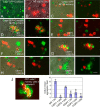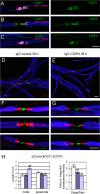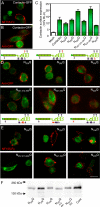Specific contactin N-glycans are implicated in neurofascin binding and autoimmune targeting in peripheral neuropathies
- PMID: 24497634
- PMCID: PMC3953301
- DOI: 10.1074/jbc.M113.528489
Specific contactin N-glycans are implicated in neurofascin binding and autoimmune targeting in peripheral neuropathies
Abstract
Cell adhesion molecules (CAMs) play a crucial role in the formation of the nodes of Ranvier and in the rapid propagation of the nerve impulses along myelinated axons. These CAMs are the targets of autoimmunity in inflammatory neuropathies. We recently showed that a subgroup of patients with aggressive chronic inflammatory demyelinating polyradiculoneuropathy (CIDP) shows autoantibodies to contactin (1). The complex of contactin·Caspr·neurofascin-155 (NF155) enables the formation of paranodal junctions, suggesting that antibody attack against paranodes may participate in the severity of CIDP. In the present study, we mapped the molecular determinants of contactin targeted by the autoantibodies. In three patients, immunoreactivity was directed against the Ig domains of contactin and was dependent on N-glycans. The serum of one patient was selectively directed against contactin bearing mannose-rich N-glycans. Strikingly, the oligomannose type sugars of contactin are required for association with its glial partner NF155 (2). To investigate precisely the role of contactin N-glycans, we have mutated each of the nine consensus N-glycosylation sites independently. We found that the mutation of three sites (N467Q/N473Q/N494Q) in Ig domain 5 of contactin prevented soluble NF155-Fc binding. In contrast, these mutations did not abolish cis-association with Caspr. Next, we showed that the cluster of N-glycosylation sites (Asn-467, Asn-473, and Asn-494) was required for immunoreactivity in one patient. Using cell aggregation assays, we showed that the IgGs from the four CIDP patients prevented adhesive interaction between contactin·Caspr and NF155. Importantly, we showed that the anti-contactin autoantibodies induced alteration of paranodal junctions in myelinated neuronal culture. These results strongly suggest that antibodies to CAMs may be pathogenic and induce demyelination via functional blocking activity.
Keywords: Cell Adhesion; Cell Surface Protein; Glycoprotein; Myelin; Neuroinflammation.
Figures









References
-
- Querol L., Nogales-Gadea G., Rojas-Garcia R., Martinez-Hernandez E., Diaz-Manera J., Suárez-Calvet X., Navas M., Araque J., Gallardo E., Illa I. (2013) Antibodies to contactin-1 in chronic inflammatory demyelinating polyneuropathy. Ann. Neurol. 73, 370–380 - PubMed
-
- Eshed Y., Feinberg K., Poliak S., Sabanay H., Sarig-Nadir O., Spiegel I., Bermingham J. R., Jr., Peles E. (2005) Gliomedin mediates Schwann cell-axon interaction and the molecular assembly of the nodes of Ranvier. Neuron 47, 215–229 - PubMed
-
- Sherman D. L., Tait S., Melrose S., Johnson R., Zonta B., Court F. A., Macklin W. B., Meek S., Smith A. J., Cottrell D. F., Brophy P. J. (2005) Neurofascins are required to establish axonal domains for saltatory conduction. Neuron 48, 737–742 - PubMed
Publication types
MeSH terms
Substances
LinkOut - more resources
Full Text Sources
Other Literature Sources
Medical
Molecular Biology Databases

